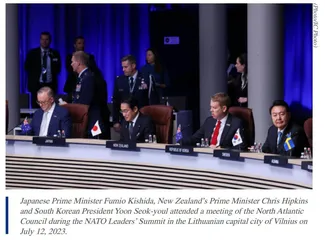Asia-Pacific Security Situation and Strategic Response Under Great Changes
作者: Zhang Jie

Our world today is going through accelerated transformation unseen in a century. The new round of scientific and technological revolution and industrial transformation is gaining steam, the international balance of power is undergoing profound adjustment, and China’s development is facing new strategic opportunities. The Asia-Pacific region, as the center of global economic growth and the focus of major country competition, has fully embodied the characteristics of the once-in-a-century changes in its overall development momentum. Against the backdrop of the intertwining of traditional and non-traditional security and the US comprehensive strategic competition with China, major forces in the region are having realignment and reconfiguration. Small and medium-sized countries are cautiously weighing between strategic autonomy and choosing sides. What has a more fundamental impact in the long run is the profound adjustments of the industrial chains and supply chains in the region. In the face of regional changes, China has the courage to take on its responsibilities, and in practice, commit itself to maintaining a just, inclusive, balanced and cooperative regional order. In particular, the Central Conference on Work Relating to Foreign Affairs held in December 2023 has pointed the direction, offered a guide to action and a path to practice for advancing the building of an Asia-Pacific community with a shared future.
Continued Reconfiguration of Regional Forces Exacerbates Regional Turbulence
The ongoing reconfiguration of major forces in the Asia-Pacific region keeps shaping the regional security pattern. For instance, the US alliance system is developing in the direction of “expansion” and “upgrading”, which has become a major destabilizing factor that intensifies confrontation between regional camps and volatility in the security situation.
In recent years, despite the continuation of the Ukraine crisis and the Palestinian-Israeli conflict, the US has not weakened its “attention” to the “Indo-Pacific” region, and still regards China as its biggest strategic competitor. With “integrated deterrence” as the strategic guide, the US has continued to consolidate its absolute military superiority in the Asia-Pacific region. In 2023, the US prioritized deepening the cooperation within its alliance system. To be specific, it strengthened the US-Japan and US-Philippines bilateral alliances with Japan and the Philippines as the “dual centers”. Building on this, the US further promoted US-Japan-ROK, US-Japan-Philippines, US-Australia-Philippines and other small-scale multilateral military cooperation, including advancing information-sharing, upgrading joint exercises and training, and enhancing interoperability. It also pushed Japan and the Philippines, Japan and Australia, Australia and the Philippines, among other countries, to negotiate and sign Reciprocal Access Agreements and Visiting Forces Agreements. All of these moves are aimed at enhancing the integration of the US military alliance and its war-fighting capability of military operations.
Breaking down geographical constraints and realizing the strategic coordination between the Asia-Pacific alliance system and NATO has become the focus of the US military security strategy. In July 2023, NATO once again invited Japan, the ROK, Australia, and New Zealand to participate in its summit and organized a group meeting between leaders of NATO member states and leaders of the four countries, with the intention of reinforcing the “determination” to work closely with each other. On this, China points out that although NATO claims to be a defensive alliance, it keeps expanding its power beyond its borders and stirring up confrontation in the Asia-Pacific region. NATO’s move eastward into the Asia-Pacific region will only stir up regional tensions and trigger confrontation and even a “new Cold War”.
Under the context of the US strategic competition with China, major countries in the Asia-Pacific region have adjusted their foreign strategies and accelerated their pace of picking sides. Among them, Japan, the ROK, Australia and other countries have further turned to the US and strengthened military cooperation within the alliance system. Since the outbreak of the Ukraine crisis, Japan’s “two in one” pattern of aggressive diplomacy and offensive security policy have been further manifested. Taking advantage of the opportunity of G7 presidency in 2023, Japan actively helped the US align its “Indo-Pacific” allies with NATO by inviting the ROK, Australia, India, Indonesia, Vietnam to the G7 Summit. In the meantime, Japan has continued to prioritize Southeast Asia and helped the US strengthen maritime security cooperation with ASEAN countries. In April 2023, Japan established the Official Security Assistance mechanism, through which it focused on strengthening maritime security cooperation with the Philippines, Malaysia, and Vietnam. In December of the same year, Japan delivered a coastal radar system to the Philippines, the first major transfer of military equipment since the lifting of Japan’s post-war ban on defense exports in 2014.
In early 2023, Japan and the ROK reconciled at the political level. On that basis, the US, Japan and the ROK have worked actively to build their trilateral relations. In the same year, these three countries held several rounds of meetings, including the first Economic and Security Dialogue and the trilateral Camp David Summit, to extend trilateral cooperation from the past security-oriented cooperation to economy, technology and other areas, and to expand cooperation from Northeast Asia to a wider range of regions, including the Taiwan Strait and the South China Sea. That said, due to the long-standing grudges between Japan and the ROK in history, culture, territorial disputes and other areas, there’s still a possibility of reversal of the relationship between the two countries. Hence, it’s difficult for the US, Japan and the ROK to form a trilateral military alliance yet.